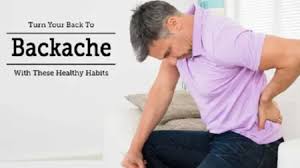
Backache
Published Date: 6/17/2023 6:04:03 AM
- Backache is one of the most common medical complaints, particularly among adults. Backache usually refers to pain in your muscles, intervertebral joints, spinal nerves, or sometimes bone-on-bone pain. The type of pain you are having can help your physician pinpoint the cause.
- Backache can be categorized as acute or chronic. Acute pain is often temporary and can improve on its own, frequently without treatment or with the assistance of a mild pain-relieving medication. Acute backache usually lasts anywhere from a couple of days to several weeks. Chronic back pain is more long-term and can extend beyond several months. The pain can often be progressive, getting worse over time.
Symptoms:
- The main symptom of back pain is an ache or pain anywhere in the back, and sometimes all the way down to the buttocks and legs.
- Some back issues can cause pain in other parts of the body, depending on the nerves affected.
- The pain often goes away without treatment, but if it occurs with any of the following people should see their doctor:
- weight loss
- fever
- inflammation or swelling on the back
- persistent back pain was lying down or resting does not help
- pain down the legs
- pain that reaches below the knees
- a recent injury, blow, or trauma to the back
- difficulty urinating
- fecal incontinence, or loss of control over bowel movements
- numbness around the genitals
- numbness around the anus
- numbness around the buttocks
Treatment:
- Back pain usually resolves with rest and home remedies, but sometimes medical treatment is necessary.
Home treatments:
- Over-the-counter (OTC) pain relief medication, usually nonsteroidal anti-inflammatory drugs ( NSAID ), such as ibuprofen, can relieve discomfort. Applying a hot compress or an ice pack to the painful area may also reduce pain.
- Resting from strenuous activity can help, but moving around will ease stiffness, reduce pain, and prevent muscles from weakening.
Medical treatment:
- If home treatments do not relieve back pain, a doctor may recommend the following medication, physical therapy, or both.
- Medication: Back pain that does not respond well to OTC painkillers may require a prescription NSAID. Codeine or hydrocodone, which are narcotics, may be prescribed for short periods. These require close monitoring by the doctor. In some cases, muscle relaxants may be used.
- Antidepressants, such as amitriptyline, may be prescribed, but research is ongoing to their effectiveness, and the evidence is conflicting.
- Physical therapy: Applying heat, ice, ultrasound, and electrical stimulation — as well as some muscle-release techniques to the back muscles and soft tissues — may help alleviate pain.
- As the pain improves, the physical therapist may introduce some flexibility and strength exercises for the back and abdominal muscles. Techniques for improving posture may also help.
- The patient will be encouraged to practice the techniques regularly, even after the pain has gone, to prevent back pain recurrence.
- Cortisone injections: If other options are not effective, these may be injected into the epidural space, around the spinal cord. Cortisone is an anti-inflammatory drug. It helps reduce inflammation around the nerve roots. Injections may also be used to numb areas thought to be causing the pain.
- Botox: Botox (botulism toxin), according to some early studies, are thought to reduce pain by paralyzing sprained muscles in spasm. These injections are effective for about 3 to 4 months.
- Traction: Pulleys and weights are used to stretch the back. This may result in a herniated disk moving back into position. It can also relieve pain, but only while traction is applied.
- Cognitive-behavioral therapy (CBT): help manage chronic back pain by encouraging new ways of thinking. It may include relaxation techniques and ways of maintaining a positive attitude. Studies have found that patients with CBT tend to become more active and do exercise, resulting in a lower risk of back pain recurrence.
Complementary therapies:
Complementary therapies may be used alongside conventional therapies or on their own.
Chiropractic, osteopathy, shiatsu, and acupuncture may help relieve back pain, as well as encouraging the patient to feel relaxed.
- An osteopath specializes in treating the skeleton and muscles.
- A chiropractor treats joint, muscle, and bone problems. The main focus is the spine.
- Shiatsu, also known as finger pressure therapy, is a type of massage where pressure is applied along energy lines in the body. The shiatsu therapist applies pressure with the fingers, thumbs, and elbows.
- Acupuncture originates from China. It consists of inserting fine needles and specific points in the body. Acupuncture can help the body release its natural painkillers - endorphins - as well as stimulating nerve and muscle tissue.
- Yoga involves specific poses, movements, and breathing exercises. Some may help strengthen the back muscles and improve posture. Care must be taken that exercises do not make back pain worse.
Mudra Therapy For Backache:
- VAYU MUDRA + APAN VAYU MUDRA + VATA NAASHAK MUDRA
- MERUDANDA MUDRAS (AS PER LOCATION OF PAIN) + SAHAJA SHANKHA MUDRA +
PRAN MUDRA